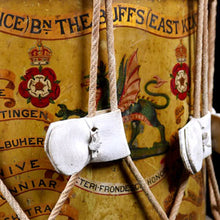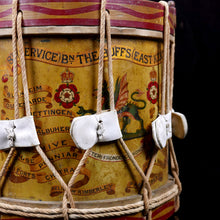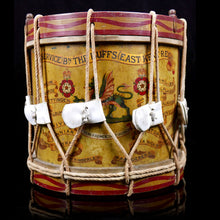A First World War Side Drum of The Buffs (East Kent Regiment), 1914
- Regular price
- £1,600
- Sale price
- £1,600
- Regular price
-
- Unit price
- /per
Adding product to your cart
Height overall: 36.5cm (14.3in)
8th (Service) Battalion, East Kent Regiment (The Buffs) side drum with brass cylinder, wood hoops, leather tab and rope tensioning system. Emblazoned with twin crowned Tudor roses and ancient dragon vert on a buff ground over the motto ‘Veteri Frondescit Honore’ (Its Ancient Honour Flourishes), flanked by Battle Honours from Blenheim to the end of the South Africa 1900-02. Cylinder stamped ‘Hawkes & Son / Makers / London’.
8th (Service) Battalion, East Kent Regiment (The Buffs) was raised at Canterbury in September 1914 as part of Kitchener's Third New Army and joined 72nd Brigade, 24th Division. The Division began to assemble in the area of Shoreham but suffered from a lack of equipment and a lack of trained officers and NCOs to command the volunteers. In late June 1915 they moved to Aldershot for final training and they proceeded to France at the end of August. The Division concentrated in the area between Etaples and St Pol on the 4th of September and a few days later marched across France into the reserve for the British assault at Loos, going into action on the 26 September and suffering heavy losses. In October the 8th Buffs transferred to 17th Brigade, still with 24th Division. In 1916 they suffered in the German gas attack at Wulverghem and then moved to the Somme seeing action in Delville Wood and at Guillemont. In 1917 they were in action at Vimy Ridge in the spring, Messines in June and Third Ypres in October before moving south where they were in took part during the Cambrai operations when the Germans counter attacked. When the army was reorganised in February 1918 the 8th Buffs were disbanded in France.
Read more
The dragon, a supporter in the arms of Queen Elizabeth I, was given as a badge to Thomas Morgan's Company of Foot, The London Trained Bands, which existed between 1572 to 1648, and which is perceived as an ancestor of the The Buffs. Morgan’s Company fought in the Low Countries during the Dutch Revolt and in the Anglo-Spanish War (1585-1604). In the 18th century both the dragon and the buff facings (worn on cuffs, lapels and coat linings) remained particular distinctions of the regiment. A Royal Warrant of 1751 standardising all colours, insignia and uniforms listed the regiment as the ‘3rd Regiment, or The Buffs’.






